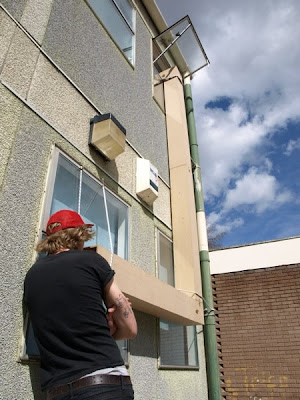
Saturday, 16 May 2009
Friday, 15 May 2009
Monday, 27 April 2009
Sunday, 19 April 2009
Saturday, 11 April 2009
Tuesday, 7 April 2009
Sunday, 5 April 2009
Sunday, 22 March 2009
Wednesday, 18 March 2009
'An urban, contemporary, and ever-changing aesthetic variation on the 18th-century landscape painting tradition, Sky Mirror literally brings the sky down to the ground. The large, 23-ton circular stainless steel sculpture is installed on a platform a few feet above street level. Its concave side, angled upward, faces 30 Rockefeller Plaza, reflecting an upside-down portrait of this elegant and iconic New York City skyscraper and the shifting sky around it. Its convex side, facing Fifth Avenue reflects a more earthly vision: viewers in the midst of the adjacent streetscape. This optical object changes through the day and night and is an example of what Kapoor describes as a "non-object," a sculpture that, despite its monumentality, suggests a window or void and often seems to vanish into its surroundings.'
Tuesday, 17 March 2009
Tuesday, 24 February 2009
Monday, 2 February 2009
1.
'There is a specific metaphor contained in the position of the viewer himself as well. He, the viewer, is either a complete outsider vis-a-vis the fate of the people inside the room- he is a 'person on the roof' - or on the other hand, dropping into any one of these rooms, submerging himself into an ordinary 'family' story, he understands that this is also 'about him' and he experienced the same things in his life, and he is just the same as 'they' are, the same as everybody else...'
(On the Roof)
2.
' the only way and means to lead a worthy human life is to have one's own project, [...] to realise it, perhaps, should be inherent in every person, the project is the concentration, the embodiment of the meaning of life, only thatnks to it can he establish "who he is," what he is capable of [...] It is only from the moment of the determination of his project that his true "existence" and not just "survival" begins.'
(A Palace of Projects)
Ilya & Emilia Kabakov
http://www.ilya-emilia-kabakov.com/
'There is a specific metaphor contained in the position of the viewer himself as well. He, the viewer, is either a complete outsider vis-a-vis the fate of the people inside the room- he is a 'person on the roof' - or on the other hand, dropping into any one of these rooms, submerging himself into an ordinary 'family' story, he understands that this is also 'about him' and he experienced the same things in his life, and he is just the same as 'they' are, the same as everybody else...'
(On the Roof)
2.
' the only way and means to lead a worthy human life is to have one's own project, [...] to realise it, perhaps, should be inherent in every person, the project is the concentration, the embodiment of the meaning of life, only thatnks to it can he establish "who he is," what he is capable of [...] It is only from the moment of the determination of his project that his true "existence" and not just "survival" begins.'
(A Palace of Projects)
Ilya & Emilia Kabakov
http://www.ilya-emilia-kabakov.com/
Wednesday, 28 January 2009
Sunday, 14 December 2008
Saturday, 13 December 2008
 The Art of Living: Saul Steinburg.
The Art of Living: Saul Steinburg.Fantastic book of illustrations. one page in the book (not displayed here as i couldn't find it) depicts a scene from a house, with the front façade removed, revealing a glimpse into the events within. The goings on of the some 23 rooms inside include a range of mundane activities dramatised with line, submerged in a swamped mass of detail. These include a man having a shower in the lower floor bathroom, one upright piano with stool, three fireplaces, of which only one is working, one doll in a pram and a number of termites. The drawings hold a great amount of layers, and not only can they be studied to find a series of 'where's wally' type findings, but also their content encourages you to raise questions and form conclusions about the sketches themselves; their intention often illusionary. For example. The scene appears to be a house, which brings to mind a series of questions concerning the characters going about their day to day activities within. Primarily, there are 26 persons within the house, which by no means is a traditional nuclear family. This encourages us to search for clues within the scene that could give us a solution. A small sign next to the door solves the problem; displaying the words 'no vacancy.' It is here that the narrative of the scene begins to be unpicked by a series of clues left by the artist.
Saturday, 6 December 2008
Subscribe to:
Posts (Atom)





























